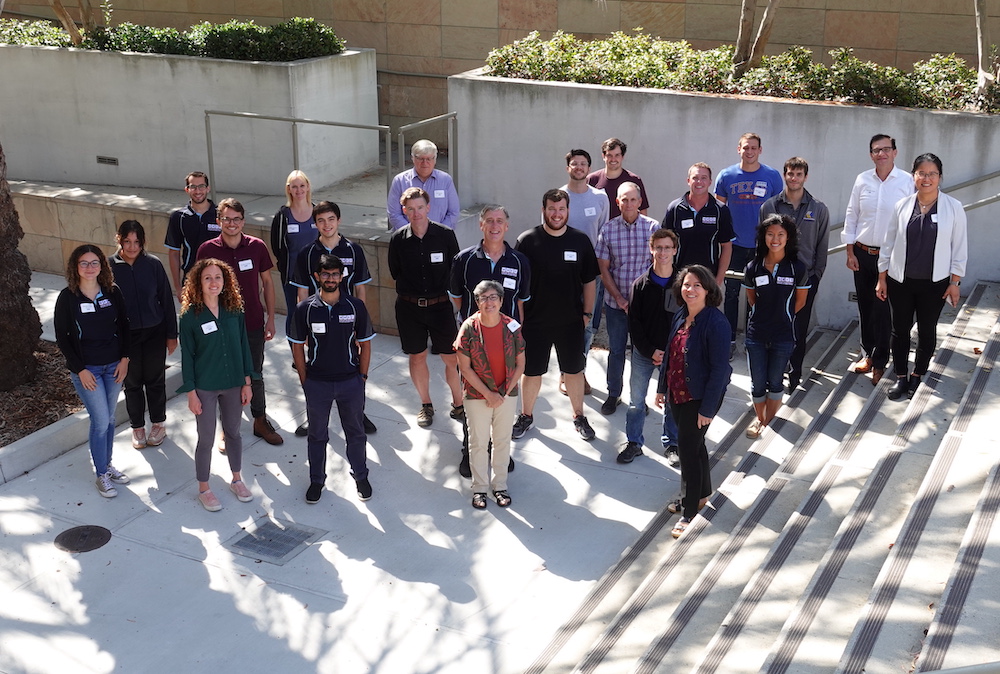The Center for Materials for Water and Energy Systems (M-WET) has been studying novel membrane-based approaches — and new materials — to change how we purify water for four years, and that work will continue after the U.S. Department of Energy (DOE) renewed funding for the initiative. M-WET will receive an additional $12 million over another four years, through DOE’s Energy Frontier Research Center Program.
 M-WET is a collaboration between researchers at The University of Texas at Austin; the University of California, Santa Barbara; and Lawrence Berkeley National Laboratory, and it is headquartered in the Cockrell School of Engineering at The University of Texas at Austin. Together, this group of more than 40 scientists and engineers from a variety of backgrounds apply state of the art materials synthesis, characterization and modeling to the challenge of developing sustainable water treatment technologies. Decontamination of wastewater from energy-related uses can provide water for a large number of applications and, in some instances, can be used to recover other valuable resources, such as lithium, which could markedly increase lithium availability for batteries (used for energy storage).
M-WET is a collaboration between researchers at The University of Texas at Austin; the University of California, Santa Barbara; and Lawrence Berkeley National Laboratory, and it is headquartered in the Cockrell School of Engineering at The University of Texas at Austin. Together, this group of more than 40 scientists and engineers from a variety of backgrounds apply state of the art materials synthesis, characterization and modeling to the challenge of developing sustainable water treatment technologies. Decontamination of wastewater from energy-related uses can provide water for a large number of applications and, in some instances, can be used to recover other valuable resources, such as lithium, which could markedly increase lithium availability for batteries (used for energy storage).
Benny Freeman, M-WET director and a professor in the McKetta Department of Chemical Engineering at UT Austin said, “In its first four years, M-WET scientists worked across numerous disciplinary boundaries to address basic science challenges related to water purification membranes that no one group or discipline could address alone, produced a substantial body of impactful literature, launched the careers of many early stage researchers, spawned a startup focused on novel lithium extraction processes, and used advanced spectroscopy to probe new, fundamental, molecular level properties of membranes.” He continued, “Looking towards the future, we will build upon these successes, discovering fundamental design rules to prepare novel membranes, training the next generation of interdisciplinary scientists in this area, and positively impacting water and energy security for our future.”
Synthetic polymer membranes provide energy efficient methods to purify water. However, water from more complex sources than lakes, river or seawater, such as produced water from oil and gas production, requires separation properties that current membranes don’t provide . For example, current membranes lack adequate selectivity for some contaminants, and membrane performance is always reduced by fouling (clogging) of the membranes.
 Basic gaps in scientific knowledge regarding the behavior of complex aqueous mixtures at membrane interfaces limit our ability to design radically new, high-performance membrane materials. Moreover, current methods for synthesis and assembly of such novel materials are not amenable to scalable manufacturing, limiting the ability to create membranes that can decontaminate large amounts of complex aqueous mixtures and be highly selective to recover valuable solutes (e.g., lithium) from such streams.
Basic gaps in scientific knowledge regarding the behavior of complex aqueous mixtures at membrane interfaces limit our ability to design radically new, high-performance membrane materials. Moreover, current methods for synthesis and assembly of such novel materials are not amenable to scalable manufacturing, limiting the ability to create membranes that can decontaminate large amounts of complex aqueous mixtures and be highly selective to recover valuable solutes (e.g., lithium) from such streams.
“Energy and water are inextricably tied where the purification of water is undeniably energy intensive and the production of energy generates uniquely contaminated water," said Rachel Segalman, chair of the Department of Chemical Engineering at UC Santa Barbara and one of M-WET's associate directors. "This center brings together the expertise developed over the last decades to make designer polymers with the ability to design scalable membrane separations process to address this unique challenge. We will be specifically seeking to understand exploit the interaction of water and solutes with polymer chemistries to make new, highly efficient membranes. While this center is focused on the fundamental design rules, we anticipate having a major impact both in the development of novel membranes and in the training of a new generation of scientists who bridge polymer and membrane science, chemical engineering, and environmental engineering.”
M-WET’s unique team of researchers bring complementary expertise in water chemistry, polymer science, surface chemistry, materials science and advanced materials characterization methods with extensive practical knowledge of water treatment and membrane processes. Their focus on fundamental research promises to speed identification and preparation of new membrane materials with superior properties for energy-efficient recycling, repurposing and purifying what many consider to be the most valuable resource on earth.
“The nation’s existing water infrastructure is inadequate to address increased water scarcity associated with climate change, population growth, industrialization, and urbanization,” said Lynn Katz, professor in the Department of Civil Architectural and Environmental Engineering at UT Austin and one of M-WET’s associate directors. “The use of more complex, alternative water sources is necessary to address this demand. Many of us in M-WET have spent our careers studying water, but the collaborative, interdisciplinary nature of the M-WET team has been a key to advancing our ability to design new materials for treating lower quality water sources.”






